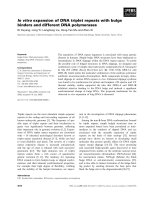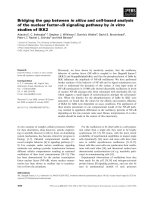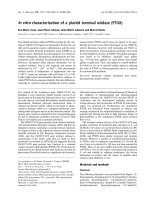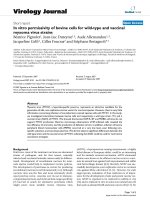IN VITRO PROPAGATION OF POINSETTIA(Euphorbia pulcherrima Willd.)
Bạn đang xem bản rút gọn của tài liệu. Xem và tải ngay bản đầy đủ của tài liệu tại đây (303.86 KB, 7 trang )
<span class='text_page_counter'>(1)</span><div class='page_container' data-page=1>
<b>IN VITRO PROPAGATION OF POINSETTIA</b>
<i><b> (Euphorbia pulcherrima Willd.) </b></i>
<i>Le Hong Thuy Tien, Nguyen Thi Diep, Nguyen Vu Phong</i>
<i>Nong Lam University, Ho Chi Minh city</i>
<i>Email: </i>
<b>ABSTRACT</b>
<i>Poinsettia plants (Euphorbia pulcherrima Willd.) is a flowering potted plant with an high </i>
<i>economic value, especially in Christmas and New Year. Conventional propagation of poinsettia by </i>
<i>seed and cuttings has several limitations due to genetic variability and a low rate of propagation. </i>
<i>This study presents the results of in vitro propagation for poinsettia. Nodal segments with axillary </i>
<i>buds were sterilized with javel:distilled water at ratio 1:2 (v/v) in 15 minutes obtained 53.3% </i>
<i>cleaned samples. Effect of 6-benzyladenine (BA), naphthalene acetic acid (NAA), gibberellin acid </i>
<i>3 (GA<sub>3</sub>), indole 3- butyric acid (IBA) on in vitro shoot and root formation was studied. </i>
<i>Full-strength Murashige and Skoog (MS) medium supplemented with 0.5 mg.L-1<sub> BA and 0.1 mgL</sub>-1</i>
<i>NAA was the best for shooting (4.8 shoots per explant). Shoots were transferred onto MS medium </i>
<i>adding 0.3 mg.L-1<sub> GA</sub></i>
<i>3 for elongation within 4 weeks. The elongated shoots were rooted on </i>
<i>half-strength MS medium containing 2 mg.L-1 <sub>IBA and plantlets were successfully acclimatized with </sub></i>
<i>75% survival rate. </i>
<i><b>Keywords: BA, GA</b><sub>3</sub>, nodal segment, poinsettia, regeneration.</i>
<b>TÓM TẮT</b>
<i>Cây trạng nguyên (Euphorbia pulcherrima Willd.) là loại cây hoa cảnh trồng chậu có giá trị </i>
<i>kinh tế cao, rất được yêu thích đặc biệt trong dịp giáng sinh và năm mới. Việc nhân giống theo </i>
<i>phương pháp truyền thống bằng hạt hoặc cành giâm gặp hạn chế do cây con biến đổi lớn về di </i>
<i>truyền và hệ số nhân giống thấp. Nghiên cứu này trình bày kết quả nhân giống in vitro cây trạng </i>
<i>nguyên. Đoạn thân mang chồi ngủ được khử trùng với dung dịch javel:nước tỷ lệ 1:2 trong 15 phút </i>
<i>thu được 53,3% mẫu sạch. Mẫu được cảm ứng tạo đa chồi thực hiện trên môi trường cơ bản MS </i>
<i>(Murashige and Skoog, 1962) bổ sung 0,5 mg.L-1<sub> BA và 0,1 mgL</sub>-1<sub> NAA tạo được 4,8 chồi/mẫu. Sau </sub></i>
<i>4 tuần nuôi cấy trên môi trường MS bổ sung 0,3 mg.L-1<sub> GA</sub> </i>
<i>3, chồi con được cảm ứng tạo rễ dưới </i>
<i>tác dụng của 2 mg.L-1<sub> IBA trên mơi trường MS½ khơng bổ sung đường. Ngồi vườn ươm, 75% cây </sub></i>
<i>con tiếp tục sống khi được ươm trên giá thể đất, tro trấu, xơ dừa.</i>
<i><b>Từ khóa: BA, đoạn thân, GA</b><sub>3</sub>, tái sinh, cây trạng nguyên.</i>
<b>INTRODUCTION</b>
<i>Poinsettia (Euphorbia pulcherrima Willd.) </i>
is one of most favorite ornamental houseplants
with the colorful leaves, durability, and having
specific meaning Christmas and New Year
times in many countries around the world
(Clarke et al., 2008). In Vietnam, the dwarf
poinsettia with red leaves grows in pot widely
used as decoration plant. This cultivar is mainly
imported from abroad, therefore the cost is
quite high. Poinsettia is propagated by seeds;
however, it has low rate of propagation and
high genetic variation. The multiplication by
weeks for rooting. In addition, the potential
pathogenic virus is also easily transmitted
from mother plant to seedlings. Previous
studies focused on regenerating plants through
organogenesis or somatic embryogenesis that
<i>are significant to in vitro propagation although </i>
the rate of propagation is not high (De Langhe
et al., 1974; Roy and Jinnah, 2001; Jasrai et al.,
2003, Uchida et al., 2004, Pickens et al., 2005;
Perera and Trader, 2010). The information of
<i>in vitro propagation of poinsettia in Vietnam is </i>
</div>
<span class='text_page_counter'>(2)</span><div class='page_container' data-page=2>
elongation before rooting. Height of shoot (cm)
and leaf number (leaf/shoot) were recorded after
4 weeks of culture.
<i><b>In vitro</b></i><b> rooting and acclimatization </b>
<i>The in vitro shoots were transferred to either </i>
MS basal medium (without sugar) of different
strengths (full strength and half strength of
macro nutrient) alone or supplemented with
IBA at 0,5; 1,0; 1,5; 2,0 mg.L-1<i><sub> for in vitro root </sub></i>
induction. The percentage of shoots producing
roots, the number of root was recorded after 4
weeks.
According to acclimatization and hardening,
<i>in vitro regenerated plants form 3 -5 cm height </i>
having roots were removed from test tubes
and agar medium attached was washed off
completely. Plants were transferred to plastic
pots containing mixture of clean soil : coir :
rice husk ash in the ratio of 1: 2: 3. The survival
rate of plantlets was recorded after 2 weeks of
transfer to plastic pots.
<b>Statistical analysis</b>
The experiments were arranged in a
completely randomized, single-factorized
manner. Each treatment throughout the
experimentation consisted of three replicates
and the experimental unit was ten explants per
treatment. The data were statistically analyzed,
the results were analyzed using ANOVA, the
mean and the difference table of the LSD tests.
<b>RESULTS ANS DISCUSSION</b>
<i><b>In vitro</b></i><b> explants sterilization at different </b>
<b>time of treatment with javel</b>
The culture media contains sugar, mineral
salts and vitamins are very favorable for the
growth of bacteria and mold. Microorganisms
grow much faster than the growth of plant
tissue, which invades both the culture medium
leading to the dead of explants. Therefore, plant
tissue needs to be cleared of microorganisms to
become as a raw material for subsequent trials.
<b>MATERIALS AND METHODS</b>
<b>Materials </b>
The dwarf poinsettias with red leaves were
collected from flower stores in Truong Chinh
street, Tan Binh district, Ho Chi Minh city.
MS (Murashige and Skoog, 1962), and ½
MS (macro nutrient reduces half) supplemented
with 8 g.L-1<sub> agar, 30 g.L</sub>-1<sub> sucrose (except rooting </sub>
experiment) were used as basal media. The
growth regulators such as BA (benzyl adenine),
NAA (1-naphthaleneacetic acid), IBA
(indole-3-butyric acid), and GA<sub>3</sub> (gibberellic acid)
(Himedia, India) were added to basal media at
various concentrations. The pH of the medium
was adjusted to 5.7 ± 0.1 before autoclaving at
121o<sub>C at 1.2 atm for 20 min. GA3 is sterilized </sub>
through the membrane filter and added to the
medium after sterilization.
<b>Disinfection of explants</b>
Young nodal explants with axillary buds
were washed under running tap water for 60
min then rinsed with 70% (v/v) ethanol for 30
sec. The explants were soaked with commercial
Javel solution (My Hao, Vietnam) diluted with
distilled water at ratio 1:1 or 1:2 (v/v) for 10,
15, and 20 min. Each disinfected step was
followed by a rinsing with sterile distilled water
(three times). Finally, the explants were placed
on agar-based MS medium. The percentage of
clean explants and survival rate were recorded
after two weeks of culture.
<i><b>In vitro</b></i><b> shoot proliferation</b>
Induction of shoot proliferation by culturing
the clean nodal explants with axillary buds on
the MS medium supplemented with 0.1 mg L-<sub>1 </sub>
NAA and BA concentrations ranged from 0; 0.1;
0.5; 1.0; and 1.5 mg.L-1<sub>. The average shoots per </sub>
</div>
<span class='text_page_counter'>(3)</span><div class='page_container' data-page=3>
clean explants rate and survival rate did not
differ significantly when the treatment time was
up to 20 minutes.
In general, the clean explants rate and
survival rate were quite low at all treatments
similar to the result reported by Perera and
Trader (2010). This may be due to poinsettia is a
hollow tree that endogenous fungi and bacteria
are inhabitable. In addition, young shoots are
susceptible to the effects of disinfectants leading
to dead or poor regeneration (Figure 1).
When explants were treated with
javel:distilled water at ratio 1: 1 (v/v) at different
times, the survival rate was highest at 20%.
By reducing the rate of javel (1: 2), the clean
explants rate and the survival rate increased
significantly (from 25 to 50%), indicating that
the concentration of javel significantly affected
the disinfection of explants. The highest clean
explants rate and survival rate were 53% and
50%, respectively at 15-minute treatment
(Table 1). At this concentration of javel, the
<b>Table 1. Effect of javel on disinfection of nodal explants with axillary buds </b>
Ratio of javel: distilled water
(v/v) Time of treatment (min) Clean explants rate* (%) Survival rate* (%)
1: 1 10 20.0bc <sub>13.3</sub>cd
1: 1 15 36.7abc <sub>20.0</sub>cd
1: 1 20 16.7c <sub>10.0</sub>d
1: 2 10 33.3abc <sub>26.7</sub>bc
1: 2 15 53.3a <sub>50.0</sub>a
1: 2 20 43.3ab <sub>40.0</sub>ab
<i>* Values are mean of three replicates. Values sharing common letters do not differ significantly at </i>
<i>P < 0.05 according to LSD Test.</i>
<b>Figure 1. Shoots formed from axillary buds of poinsettia</b>
<i>(a) and (b) good shoot regeneration; (c) and (d) poor shoot regeneration.</i>
<b>Effect of BA and NAA on shoot proliferation </b>
<b>Table 2. Shoot proliferation on MS medium supplemented with NAA (0.1 mg.L</b>-1<sub>) </sub>
and various concentration of BA after 4 weeks of culturing
Concentration of BA
(mg.L-1<sub>)</sub> Average shoots per explant <sub>(shoot)</sub> Height of shoot<sub>(cm)</sub> Leaf number (leaf)
0.0 26b <sub>2.0</sub>b <sub>3..5</sub>a
0.1 2.7b <sub>0.7</sub>d <sub>3.4</sub>a
0.5 4.8a <sub>1.8</sub>a <sub>2.4</sub>b
1.0 1.9bc <sub>1.2</sub>cd <sub>2.3</sub>b
1.5 1.8bc <sub>0.8</sub>d <sub>2.2</sub>b
<i>Values are mean of three replicates. Values sharing common letters do not differ significantly at P </i>
</div>
<span class='text_page_counter'>(4)</span><div class='page_container' data-page=4>
shoots/explants on the MS medium contained
0.5 mg.L-1<sub>, while the shoot height was relatively </sub>
low (< 1 cm) with many leaves (11 leaves/
shoot). Picken and co-workers (2005) used 1.5
mg. L-1<sub> IAA combined with 0 - 4 mg.L</sub>-1<sub> BA </sub>
achieved a maximum of 2.7 shoots per explant
with 40% of callus at the site of exposure.
<b>Effect of GA<sub>3 </sub></b><i><b>on in vitro shoot elongation of </b></i>
<i><b>poinsettia </b></i>
Most shoot produce a height of less than 2
cm and the number of leaves per shoot is less
than 2-3 leaves. To reach the right size before
rooting, GA3 was used to stimulate shoot
elongation.
The results show that shoot regeneration was
observed in all the medium compositions used.
MS medium supplemented with 0.1 mg.L-1 <sub>and </sub>
0.5 mg L-1<sub> BA yields the maximum amount of </sub>
shoot (4.8 shoot) compared to the other MS
media tried. The height of shoots formed on
media without BA (Fig. 2a) and BA with 0.5
mg.L-1 (Figure 2c) was highest (2.0 cm and
1.8 cm). Shoots on medium supplemented with
BA 0.1 mgL-1<sub> or without supplementation had </sub>
significantly higher leaf numbers (3.5 and 3.4
leaf) than the remaining treatments (1.6 - 2.4
leaf) (Table 2). Similar results reported by
Danial and Ibrahim (2016), they obtained 5
a b c d e
<i><b>Figure 2. In vitro shoots grow on MS supplemented with various concentration of BA </b></i>
<i>(a) 0 mg.L-1<sub>; (b) 0,1 mg.L</sub>-1<sub>; (c) 0,5 mg.L</sub>-1<sub>; (d) 1,0 mg.L</sub>-1<sub>; (e) 1,5 mg.L</sub>-1<sub>.</sub></i>
<i><b>Table 3. In vitro shoot elongation of poinsettia on medium contains GA</b></i><sub>3</sub>
Concentration of GA <sub>3</sub>
(mg.L-1<sub>)</sub> Height of shoot <sub>(cm)</sub> Leaf number <sub>(leaf)</sub>
0.0 2.0c <sub>3.5</sub>b
0.1 1.9c <sub>3.5</sub>b
0.3 2.2c <sub>4.9</sub>a
0.5 3.0ab <sub>4.9</sub>a
0.7 3.2a <sub>4.2</sub>ab
1.0 2.4bc <sub>4.4</sub>ab
<i>Values are mean of three replicates. Values sharing common letters </i>
<i>do not differ significantly at P < 0.05 according to LSD Test.</i>
On MS medium supplement with 0.5 and
0.7 mg.L-1<sub> GA</sub>
3, the height of the shoot reached
highest at 3 cm. However, shoots on the medium
supplemented with 0.5 mg L-1<sub> GA3 produced </sub>
larger and more uniform shoots (Figures 3c and
3e). On the remaining medium, the shoot height
was lower. Average leaf ranged from 3 - 5 leaves
(Table 3). Gibberellin is a natural plant growth
</div>
<span class='text_page_counter'>(5)</span><div class='page_container' data-page=5>
(Table 4). The results observed were consistent
with that of Perera and Trader (2010) achieved
3 roots per shoot after 4 months of culturing.
Similarly, the root formation of poinsettia was
good with NAA treatment and the remaining
auxin like IBA and IAA were ineffective (Danial
and Ibrahim, 2016).
In general, in this experiment, the medium
<i>and IBA concentrations did not induce good in </i>
Medium having ½ MS strength with 2
mg.L-1<sub> IBA recorded to be the best medium </sub>
giving 38.9 % root induction with an average
number of 3 roots per cultured shoot, followed
by MS contained 2 mg.L-1<sub> IBA (27.8%) with </sub>
3 roots per shoot. The number of shoot was
very low at 5 - 17% on the remaining media.
In addition, the number of roots produced from
1 to 2 roots/shoots showed that the tested IBA
a
b
e
d
c
f
<i><b>Figure 3. In vitro shoots of poinsettia at various GA</b></i><sub>3</sub> concentration
<i>(a) 0 mg.L-1<sub>; (b) 0,1 mg.L</sub>-1<sub>; (c) 0,3 mg.L</sub>-1<sub>; (d) 0,5 mg.L</sub>-1<sub>; (e) 0,7 mg.L</sub>-1<sub>; (f) 1,0 mg.L</sub>-1<sub>.</sub></i>
<b>Effect of medium and IBA concentration </b>
<b>on root formation of poinsettia </b>
<b>Table 4. Effect of medium and IBA concentration on root formation of poinsettia</b>
Medium IBA concentration <sub>(mg.L</sub><sub>-1</sub><sub>)</sub> Explant with root<sub> (%)</sub> Number of root
½ MS 0.0 5.6 0
½ MS 0.5 11.1 2
½ MS 1.0 5.6 2
½ MS 1.5 16.7 2
½ MS 2.0 38.9 3
MS 0.0 5.6 2
MS 0.5 11.1 2
MS 1.0 11.1 2
MS 1.5 11.1 2
MS 2.0 27.8 3
</div>
<span class='text_page_counter'>(6)</span><div class='page_container' data-page=6>
rate of rooting in order to produce complete
seedlings before moving to the field.
<i>vitro root formation after 4 weeks of culturing. </i>
Additional research is needed to improve the
<b>d</b>
<b>a</b> <b>b</b> <b>c</b>
<i><b>Figure 4. In vitro root formation of poinsettia on different media </b></i>
<i>(a) MS and IBA 1,0 mg.L-1<sub>; (b) ½MS and IBA 1,0 mg.L</sub>-1<sub>; (c) MS and IBA 2,0 mg.L</sub>-1<sub>; </sub></i>
<i>(d) ½MS and IBA 2,0 mg.L-1<sub>.</sub></i>
<b>Acclimatized plantlets </b>
The mixture of clean soil : coir : rice husk ash
in the ratio of 1: 2: 3 provided the good condition
for hardening of micropropagated plantlets. The
survival rate was 75 % after 2 weeks of transfer
to plastic pots. The seedlings grow and develop
normally without morphological changes. It
was recommended that the plantlets should be
sprayed regularly and placed away from direct
sunlight at about 26o<sub>C in the garden.</sub>
<b>CONCLUSION</b>
The treatment with javel: distilled water at
ratio 1: 2 (v/v) for 15 minutes showed the best
for disinfection of nodal explants. MS medium
supplemented with 0.1 mg.L-1 <sub>and 0.5 mg L</sub>-1
BA yields 4.8 shoots per explant. The shoots
were then cultured on MS supplemented with
GA<sub>3</sub> at 0.3 mg.L-1<sub>for shoot elongation and leaf </sub>
increasing. The suitable medium for rooting was
½MS (sugar free) medium contained 2 mg.L-1
<i>IBA. In vitro formed plantlets were hardened </i>
and transferred to soil with 75% survival. This
work was initiated to develop a protocol for
<i>multiplication of Euphorbia pulcherrima Willd. </i>
through nodal explants. Micropropagation
through somatic embryogenesis and rooting
should be continued in order to increase
multiplication or produce poinsettia against
viral diseases by genetic engineering.
<b>REFERENCES </b>
Clarke J.L., S. Carl, and H. Sissel (2008).
Agrobacterium tumefaciens-mediated
<i>transformation of poinsettia, Euphorbia </i>
<i>pulcherrima, with virus-derived hairpin </i>
RNA construct confers resistance to
<i>Poinsettia mosaic virus. Plant Cell Rep., </i>
27:1027–1038
De Langhe E., P. Debergh, and R.V. Rijk (1974).
<i>In vitro culture as a method for vegetative </i>
<i>propagation of Euphorbia pulcherrima. Z. </i>
<i>Pflanzenphysiol., 71: 271–274.</i>
Danial G. H., D. A. Ibrahim (2016). Efficient
Protocol of Micropropagation, and
<i>Organogenesis of Euphorbia pulcherrima </i>
<i>Willd. Plants via Stem and Leaf Segments. </i>
<i>IJAERS, 3(8): 131-137</i>
Murashige T. and F. Skoog (1962). A revised
medium for rapid growth and bioassays with
<i>tobacco tissue culture. Physiol. Plant., 15: </i>
473-497
<i>Janick J., (1979). Horticultural Science. W.H. </i>
Freeman and Company. Sanfrancisco, USA
Jasrai Y. T.; Thaker K.N. and M.C. Dsouza
<i>(2003). In vitro propagation of Euphorbia </i>
<i>pulcherrima Willd. through somatic </i>
</div>
<span class='text_page_counter'>(7)</span><div class='page_container' data-page=7>
Uchida H., O. Nakayachi, M. Otani, M.
Kajikawa, Y. Kohzu, K. Yamato, H.
Fukusawa, T. Shimada, and K. Ohyama
(2004). Plant regeneration from internode
<i>explants of Euphorbia tirucalli. Plant </i>
<i>Biotechnol., 21:397–399.</i>
Perera D. and B. W. Trader (2010) Poinsettia
<i>‘Prestige™ Red’ (Euphorbia pulcherrima) In </i>
<i>vitro Propagation. HortScience, </i>
45(7):1126-1128.
Pickens K.A., Z.M. Cheng, and R.N. Trigiano
(2005). Axillary bud proliferation of
<i>Euphorbia pulcherrima Winter Rose. In </i>
<i>vitro Cell. Dev. Biol. Plant, 41: 770–774.</i>
<i>Roy, S.K. and M. Jinnah (2001). In vitro </i>
<i>micropropagation of poinsettia (Euphorbia </i>
<i>pulcherrima Willd.). Plant Tiss. Cul., </i>
</div>
<!--links-->









